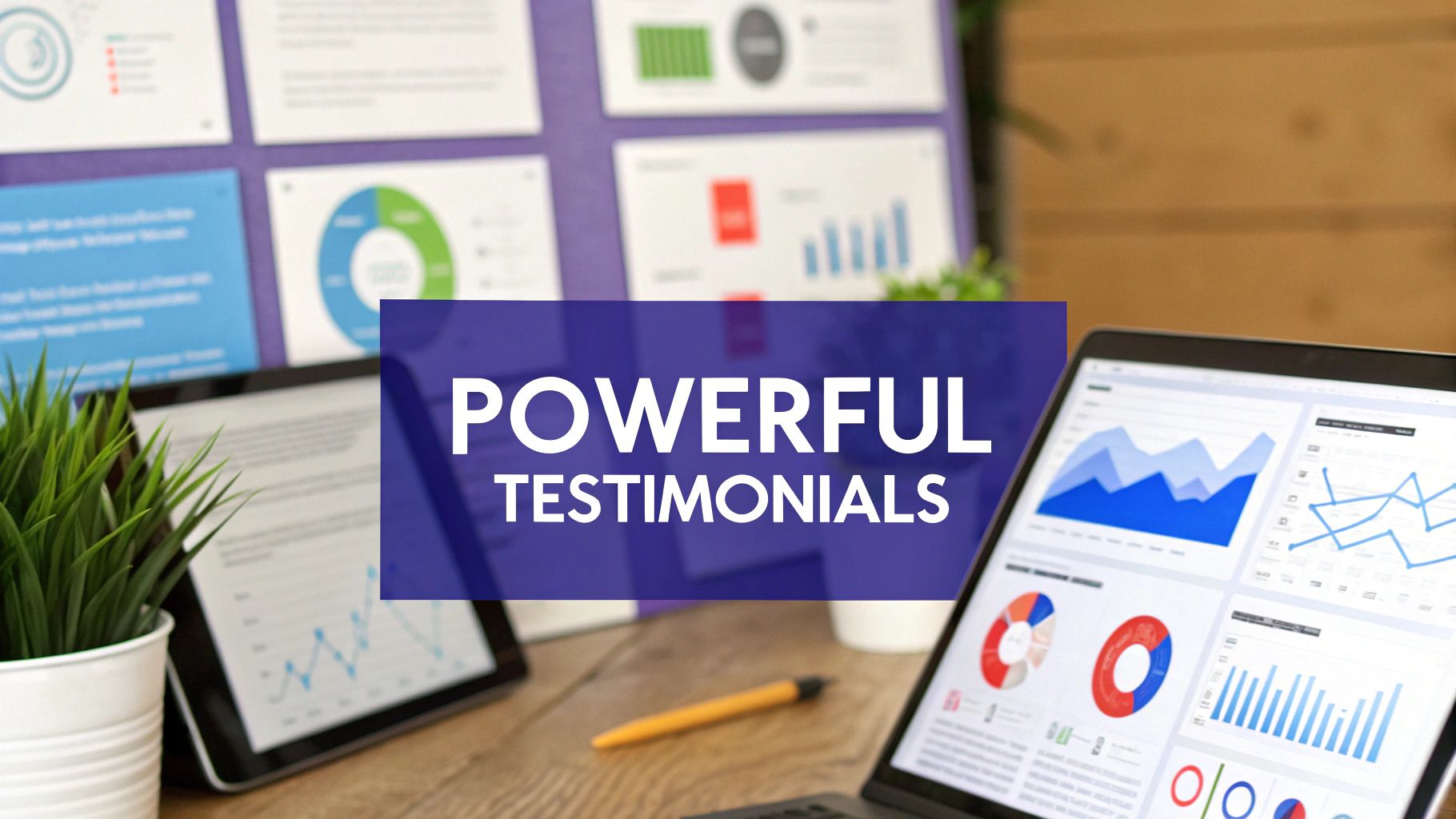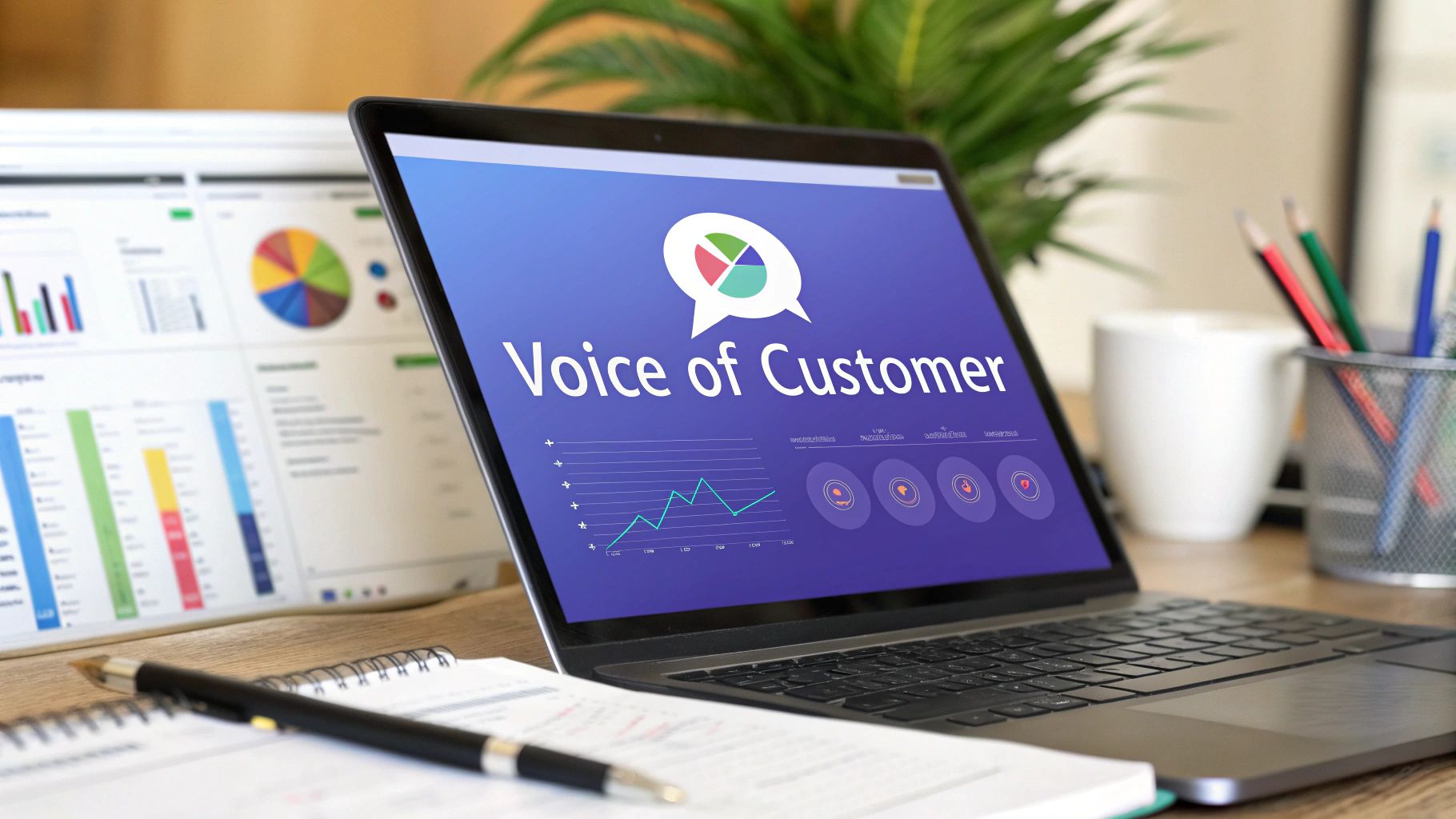Mastering the Embedded Email Survey
Learn how to use an embedded email survey to dramatically increase feedback. Get actionable tips on design, tools, and analysis for better response rates.
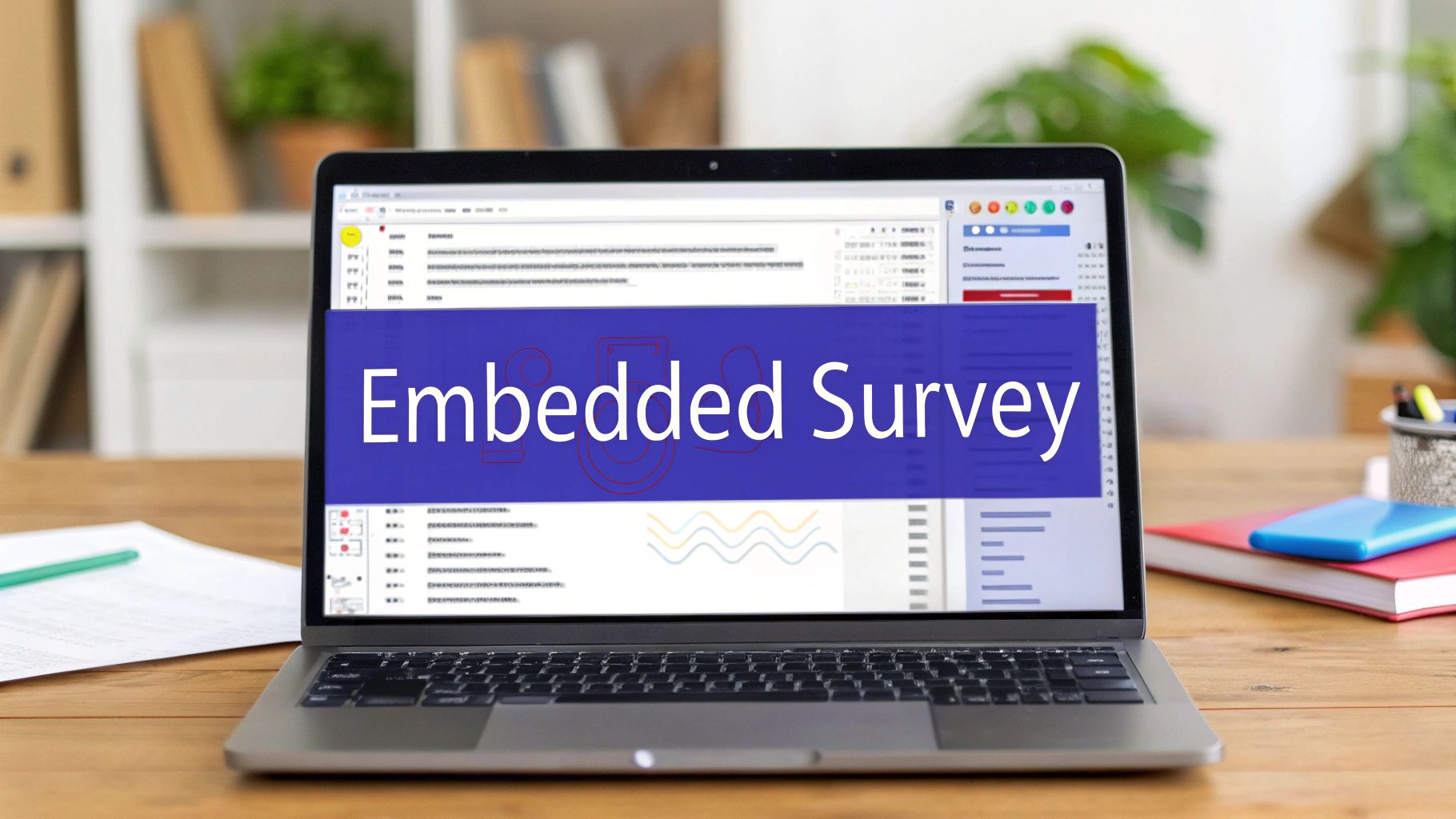
An embedded email survey is a questionnaire placed directly within the body of an email. This lets recipients answer with a single click, right from their inbox. It’s a simple change, but it completely transforms the survey experience by getting rid of the extra steps that cause people to drop off.
Why Embedded Surveys Are a Game Changer
Let's be honest: getting customers to click a link, open a new tab, and then fill out a form is a tough sell. Every extra click is another chance for them to lose interest. This is where embedded email surveys completely change the game. We're moving away from a clunky, multi-step process to an instant, in-the-moment interaction.
The magic is in reducing friction. When the first question is staring them right in the face inside the email, the barrier to entry is practically zero. This immediate engagement is incredibly powerful. In fact, research shows that embedding surveys directly into an email can boost response rates by up to 40% compared to traditional link-based surveys.
To give you a clearer picture, here’s a quick comparison of the two approaches.
Embedded Survey vs Traditional Link Survey
As you can see, the embedded approach is designed to get you more—and better—feedback with far less effort from your audience.
Authentic In-the-Moment Data
Think about it. Traditional surveys often capture feedback hours or even days after an interaction. By then, the customer's memory is foggy, and their feedback is less potent. An embedded email survey, on the other hand, captures their immediate, unfiltered thoughts.
Imagine sending a customer satisfaction survey the second a support ticket is closed. The experience is fresh, which means you get more authentic and accurate data. This kind of real-time feedback loop is absolute gold for product and customer success teams. For a closer look at how this immediacy can reshape the customer relationship, you might be interested in our guide on surveys embedded in email.
By removing the click to an external page, you're not just getting more responses—you're getting better, more honest feedback. It’s the difference between asking someone about their dinner while they’re still at the table versus asking them the next day.
Enhanced Personalization and Engagement
The power of an embedded survey is multiplied when you combine it with smart personalization. You’re not just blasting out a generic request; you’re starting a targeted, relevant conversation with a specific customer.
This kind of personalized approach is no longer a "nice-to-have"—it's a core part of modern marketing and customer engagement. To learn more about how to make your emails feel more personal and drive better results, explore this complete guide on personalized email marketing and customer engagement.
Designing a Survey People Actually Answer
Let's be honest: a successful embedded email survey isn't just a question you drop into a message. It’s a carefully crafted experience designed for instant engagement. The real secret is making the interaction so effortless that answering feels easier than ignoring it. It's time to move past those generic, clunky forms and focus on what actually gets a response.
The most effective embedded surveys I've ever seen almost always center on a single, powerful question. Think about visually engaging, one-click formats that require almost no brainpower from your recipient. These are the kinds of questions that get answered in a split second, right inside the email.
Keep It Simple and Focused
Your main goal here is to eliminate every bit of friction. Forget about asking broad, open-ended questions. Instead, stick to proven formats that are dead simple to understand and act on.
- Net Promoter Score (NPS): A simple 0-10 scale asking, "How likely are you to recommend us?" This is my go-to for gauging overall loyalty.
- Customer Satisfaction (CSAT): Use a 1-5 star or smiley face rating to ask, "How satisfied were you with your recent purchase?" It's perfect for getting immediate feedback right after an interaction.
- Customer Effort Score (CES): A straightforward "Agree/Disagree" scale for a statement like, "The company made it easy for me to handle my issue."
For instance, a confusing question like, "Based on your recent interactions and overall product usage, what is your summative evaluation of our service?" is destined for the trash folder. But a clear, simple question like, "How was your support experience today? 😊 😐 😡" will get you answers.
Here’s a perfect example of a clean, effective CSAT survey design that just begs for a quick click.
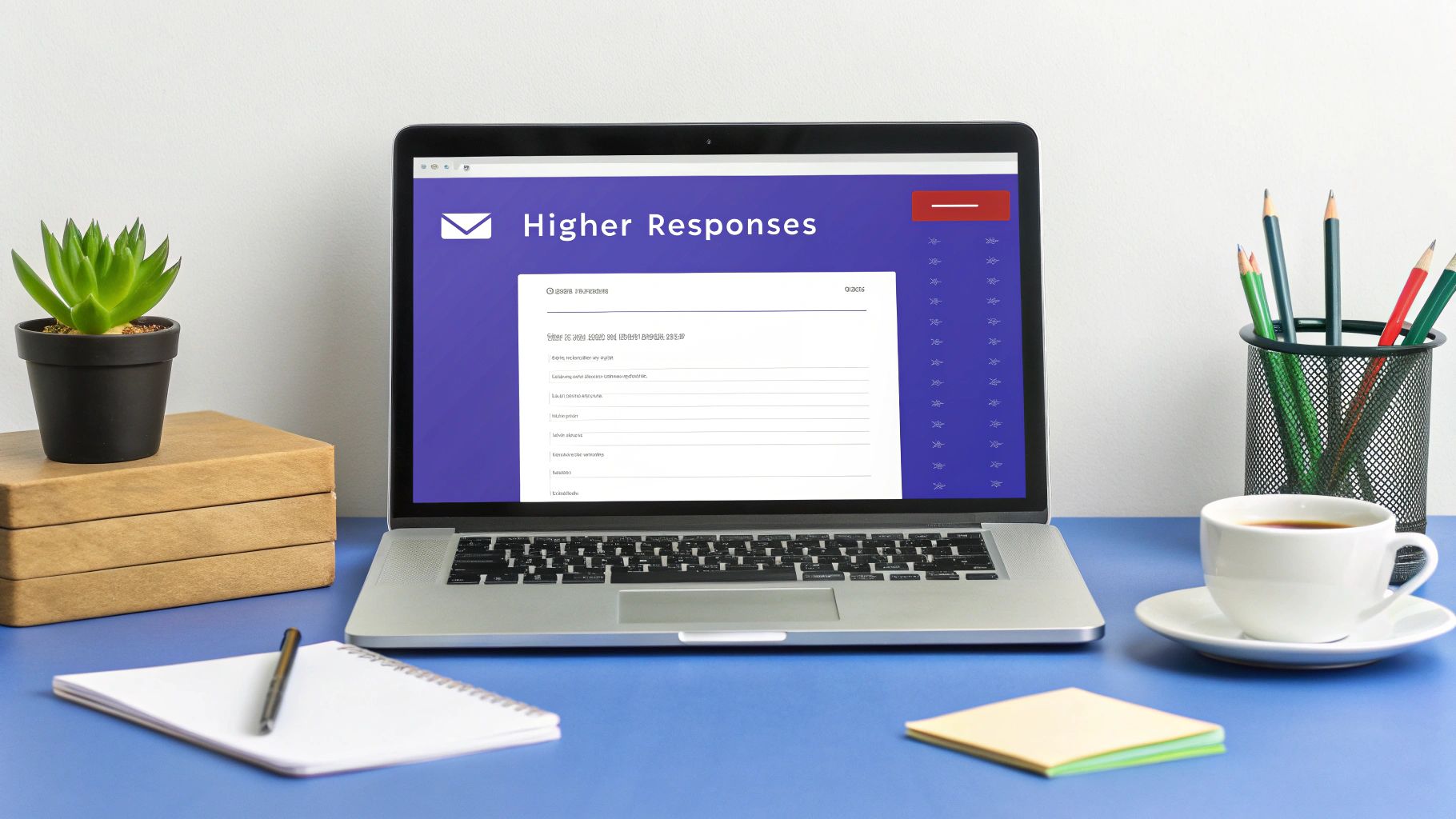
This visual approach is so intuitive. It requires just a single tap from the user to share their thoughts, which is absolutely critical for getting as many people as possible to participate.
Blend Branding and Personalization
Your survey shouldn't feel like some foreign object that got awkwardly plopped into your email. It needs to blend in seamlessly with your brand’s colors, fonts, and overall vibe. That kind of consistency builds trust and makes the whole interaction feel like a natural part of the conversation you're already having with your customer.
A well-designed embedded email survey feels less like a survey and more like a quick, personalized check-in. It respects the customer's time while giving you valuable data.
On top of that, a little personalization goes a long way. Simply addressing the recipient by name or referencing a recent purchase makes the request feel relevant and personal, not like a mass email blast. There are tons of great email personalization examples out there that can give you some inspiration for creating a more engaging experience.
Ultimately, the more you tailor the survey to the individual, the higher your response rates will climb. If you're hungry for more strategies, our complete guide on how to increase your survey response rate is packed with dozens of actionable tips.
Choosing Your Embedded Survey Toolkit
Navigating the world of feedback software can feel like a chore. With so many options out there, it's easy to get lost. But here's the thing: picking the right tool is the engine behind a successful embedded email survey program. It’s not just about flashy features; it's about finding a toolkit that genuinely fits your goals, budget, and how comfortable your team is with new tech.
Instead of just throwing a list of platforms at you, let's break down what you actually need to look for. The market is packed with everything from hyper-focused survey tools to all-in-one marketing suites that have feedback features baked in. Your decision really hinges on what you plan to do with the data once you collect it.
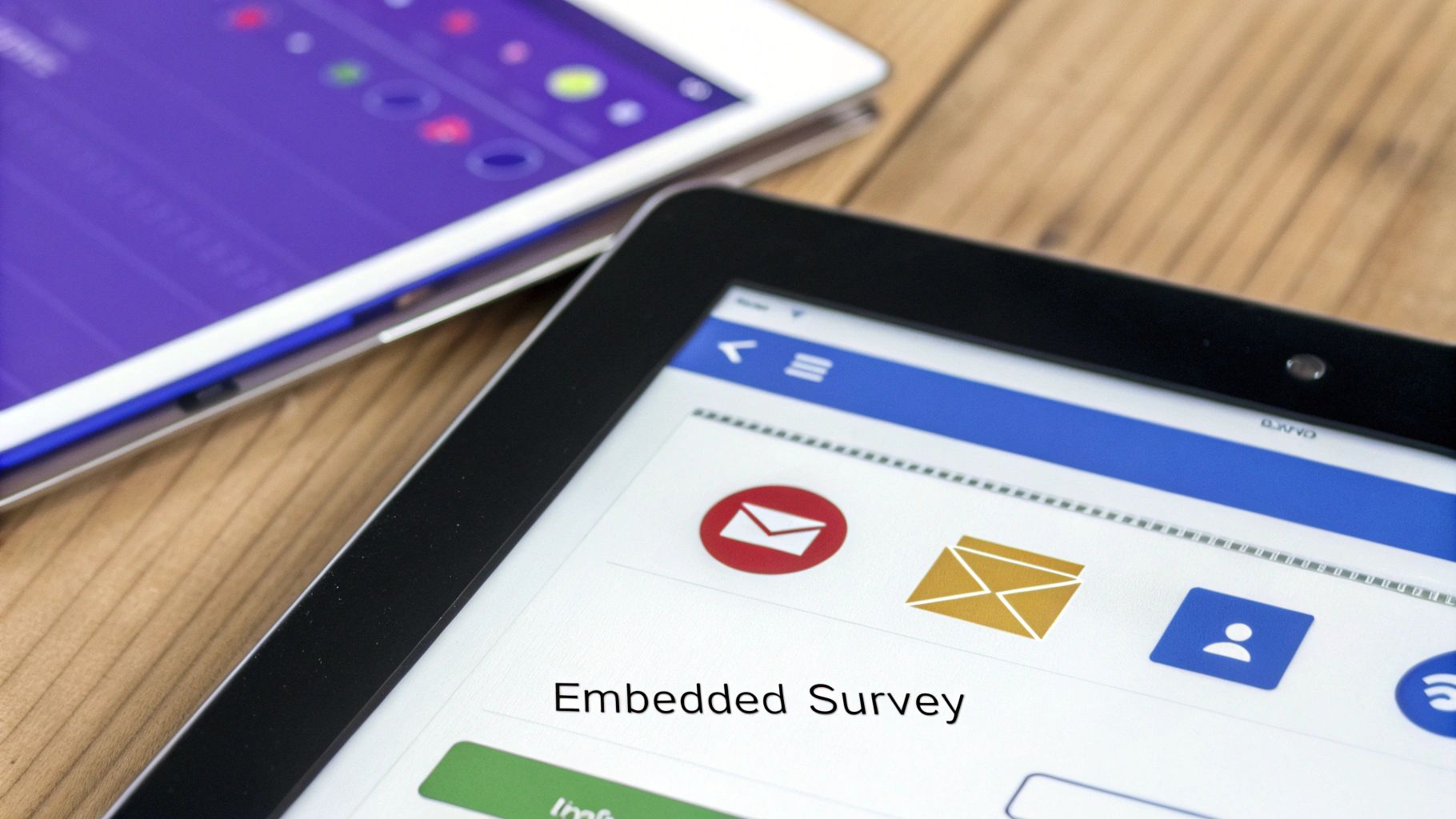
Core Integration Capabilities
The absolute must-have? Seamless integration. This is non-negotiable. Your survey tool has to play nicely with the systems you already use every day, especially your Email Service Provider (ESP) like Mailchimp or Klaviyo, and your Customer Relationship Management (CRM) software, like Salesforce or HubSpot.
If it doesn't connect, you're stuck manually exporting and importing data. That's a messy, time-consuming process that completely defeats the purpose of getting real-time feedback. You want a setup where a customer's response can instantly update their profile in your CRM, trigger a specific follow-up email, or even automatically create a support ticket. That’s where the magic happens.
Analytics That Drive Action
A pretty dashboard is nice, but analytics that actually tell you what to do next are what move the needle. Don't settle for a tool that just gives you a basic count of your responses. You need something that helps you understand the why behind the numbers.
Your toolkit shouldn't just show you your Net Promoter Score; it should help you identify trends among detractors, segment feedback by customer type, and pinpoint specific friction points in your customer journey. The goal is data that leads directly to business decisions.
The market for this tech is exploding. The global email marketing software space, which powers many of these tools, was valued at a whopping $12.88 billion in 2024. It’s projected to hit $22.81 billion by 2030. This incredible growth is fueling innovation, meaning better, more integrated solutions are hitting the market all the time. For a deeper dive into what's driving this, check out the latest trends in email marketing technology.
Dedicated vs All-in-One Platforms
So, what's the right move for you? A specialized survey tool or an email marketing suite that claims to do it all? Let's look at the options.
To make it clearer, here’s a quick comparison of the features you can expect from different types of platforms.
Key Features in Embedded Survey Tools
As you can see, the best choice depends entirely on what you're trying to accomplish.
Dedicated Survey Platforms: Tools like our own Surva.ai are built for one thing: world-class feedback collection. They offer deep, specialized features for gathering and analyzing insights. These are perfect for teams who live and breathe customer feedback and need advanced logic, powerful analytics, and slick integrations to close feedback loops fast.
All-in-One Marketing Suites: Platforms like GetResponse or Mailchimp often include basic survey functions. This is a solid starting point if your needs are simple—think adding a quick star rating to a newsletter. The trade-off is that they usually lack the analytical depth and advanced features of a dedicated tool.
Your choice ultimately comes down to your team’s maturity with feedback. If you're just dipping your toes in the water, an all-in-one suite might be enough. But if you're serious about turning customer feedback into a real growth engine for your business, a dedicated platform is a much smarter investment in the long run.
How to Embed and Send Your Survey
This is where the rubber meets the road. You’ve designed a sharp, focused question, and now it’s time to get that embedded email survey into your customers’ inboxes. The technical side of this can sound a little intimidating, but trust me, it’s usually just a simple copy-and-paste job. Let's walk through it without the confusing jargon.
Most modern survey tools, including our platform at Surva.ai, are built to make this incredibly easy. You don't need to be a coder. The platform generates all the necessary HTML code for you. Your only job is to copy this block of code and paste it into an HTML block within your email service provider’s (ESP) template editor.
It doesn’t matter if you use Mailchimp, Klaviyo, or another popular ESP—they all support adding custom HTML content. This is how your survey physically lives inside the email itself.
Handling Email Client Compatibility
Now for a crucial reality check: not all email clients are created equal. While modern clients like Gmail and Apple Mail handle interactive content beautifully, others will block it. The most notorious culprit here is usually certain versions of Microsoft Outlook, which will display your email but won't show the interactive survey elements.
Does this mean you shouldn't bother with an embedded survey? Absolutely not. It just means you need a smart fallback plan.
Your survey tool should automatically include a simple fallback link within the HTML code. If an email client can't render the interactive survey, it will display a standard link that takes the user to the survey on a web page. This ensures you never miss a response, regardless of the recipient’s email client.
This simple process flow visualizes the core steps to success.
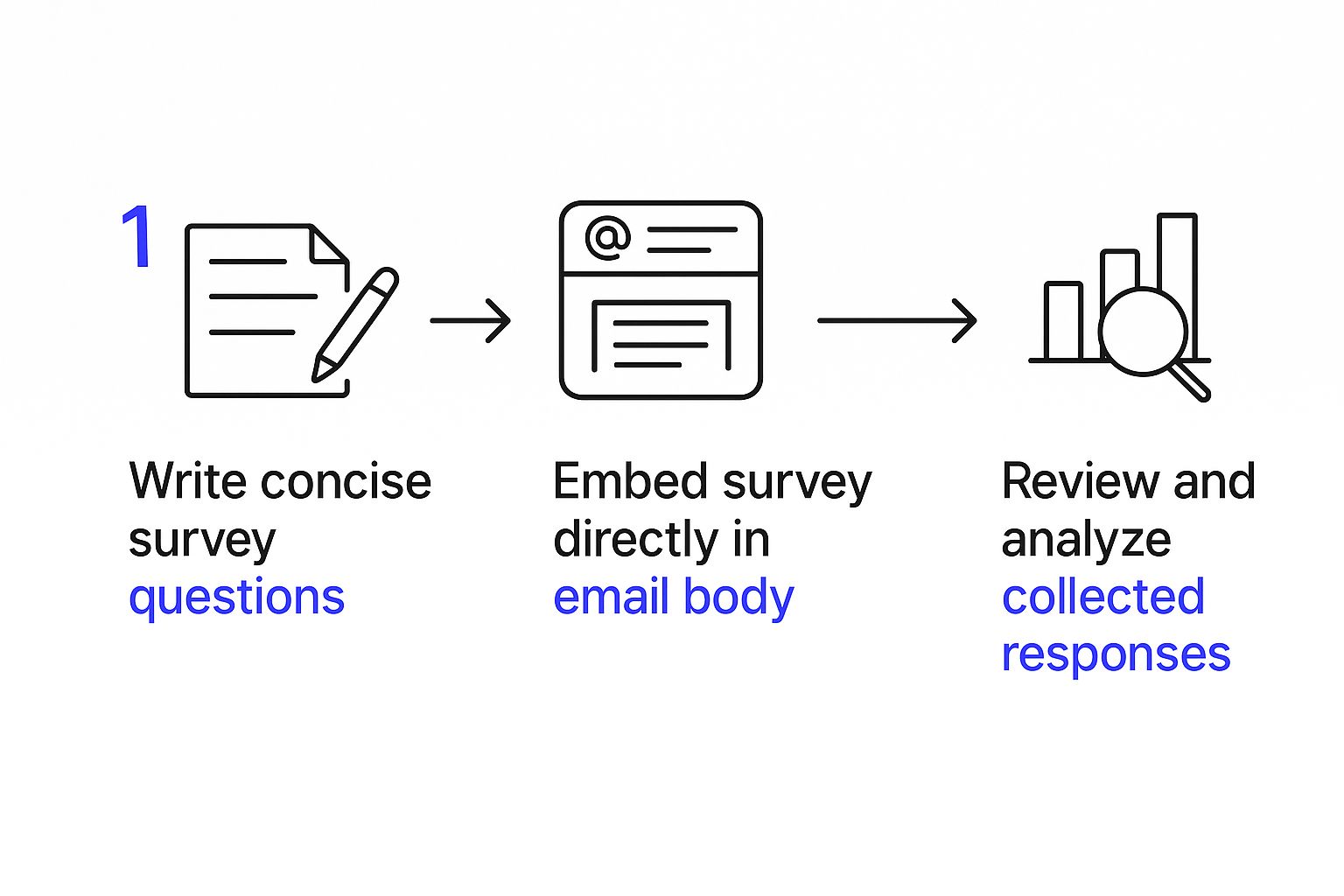
The key takeaway is a focus on simplicity at every stage. From the question design to the direct-in-email format, keeping it simple is what leads to better data.
Smart Sending Strategies for Maximum Impact
Embedding the survey is only half the battle; sending it intelligently is what actually drives results. Just blasting your entire list at once is a recipe for low engagement. Instead, you need to get more targeted with your strategies.
- Segment Your Audience: Send surveys based on user behavior. A new user might get a CSAT survey about their onboarding experience, while a long-time customer could receive an NPS survey.
- Personalize with Merge Tags: Go beyond just using their first name. Reference a specific product they bought or a support ticket they recently closed. For example, "Hi Jane, how would you rate your recent support interaction with Mark?" This context makes the request feel relevant, not random.
- Pick the Right Time: Timing really matters. Sending a B2B survey on a Friday afternoon is a terrible idea. Look at your own email engagement data to see when your audience is most active. Testing different send times is key.
Once your survey is designed and integrated, your focus needs to shift to making sure it gets seen. Learning how to boost your email open rates is paramount for maximizing survey participation. A perfectly embedded survey is useless if no one opens the email in the first place.
By combining a frictionless survey with a smart sending strategy, you create the ideal conditions for collecting that valuable, in-the-moment feedback.
Turning Feedback into Action

Getting a flood of responses from your embedded email survey feels like a big win, but honestly, that’s just the starting line. The real magic isn't in the data itself; it's in what you do with it. This is where you turn all those numbers and comments into smart business moves that actually pay off.
The trick is to look past the surface-level scores. A high Net Promoter Score is great, don't get me wrong, but the gold is usually buried in the written comments—from your biggest fans and your harshest critics. Digging into these comments helps you understand the "why" behind the numbers, revealing what your customers are really trying to tell you.
Closing the Feedback Loop
If there’s one thing you absolutely have to get right, it’s "closing the loop." This means taking real, tangible action based on the feedback and—this is the crucial part—telling your customers what you did. It shows them they aren’t just shouting into a black hole; you're actually listening and their input matters.
Imagine someone gives you a low satisfaction score. You could have an automated workflow that immediately triggers a personal follow-up email from your support team. That simple act can flip a bad experience into a great one and stop a customer from walking away. This is where a well-integrated survey really flexes its muscles.
Closing the loop is the single most effective way to build customer loyalty. It proves that providing feedback isn't a waste of time and that your company is committed to getting better.
From Insights to Communication
Acting on feedback can look different depending on the situation. Sometimes it’s as simple as an automated "thank you" message. Other times, it’s as big as fast-tracking a new feature that people have been asking for over and over again.
Here’s a quick breakdown of how you might handle different types of feedback:
- Negative Feedback: Jump on these issues right away with a personal touch. A quick, empathetic response can salvage a relationship before it’s too late.
- Neutral Feedback: These are your on-the-fence folks. Dive into their comments to find those small friction points you can smooth over.
- Positive Feedback: Don't just file it away—celebrate it! Acknowledge the praise and maybe even ask for permission to feature a glowing comment in a blog post or on social media.
This kind of communication is vital, especially when you consider how crowded inboxes are. With global email traffic projected to hit 376 billion emails per day by 2025, interactive and responsive communication is what helps you stand out.
Ultimately, you want to create a positive cycle: you ask for feedback, you act on it, you communicate the changes you've made, and you build stronger relationships. This transparent process not only helps you improve your offerings but also boosts engagement for future surveys. If you want to dive deeper, check out our guide to improve your survey response rate.
Common Questions About Embedded Surveys
Even when you've got a solid plan, a few questions always crop up when you’re trying something new. An embedded email survey is pretty straightforward, but a couple of practical—and technical—concerns tend to arise.
Let’s run through some of the most common ones. Getting these sorted out ahead of time will help you build a much more effective survey campaign from the get-go.
Will My Embedded Survey Work in All Email Clients?
This is the big one, and the honest answer is: not always.
Most modern email clients like Gmail, Apple Mail, and Yahoo Mail are fantastic at showing embedded surveys and other interactive HTML. The problem lies with some of the older or more security-conscious clients.
Desktop versions of Microsoft Outlook, for instance, are notorious for blocking certain interactive elements as a security measure. This means a portion of your audience might not see the survey exactly as you intended.
The fix? Always include a standard web link to the survey as a fallback. Any good survey tool will do this for you automatically. If the embedded version fails to load, the user still sees a clear link they can click. This is your safety net to ensure you don’t lose out on valuable feedback from anyone on your list.
This simple backup plan guarantees your survey reaches everyone, no matter what email software they’re using.
What Is the Best Question for an Embedded Survey?
Keep it simple. The most effective questions are single-click queries someone can answer without even thinking about it. The goal is to make responding an impulse action, not a chore.
A few excellent choices include:
- Net Promoter Score (NPS): "How likely are you to recommend us to a friend?" on a 0-10 scale.
- Customer Satisfaction (CSAT): "How satisfied were you with your recent support interaction?" using a star or smiley face rating.
- Binary Questions: A simple thumbs-up/thumbs-down or "Yes/No" for a quick gut check on sentiment.
The key is to avoid asking anything that requires typing. Save open-ended questions for the next step. Your only goal here is to get that first click; you can always ask for more detailed comments on the confirmation page that appears after they respond.
How Can I Stop Someone From Responding Twice?
You probably don’t have to worry about this. Most professional survey tools handle this for you right out of the box.
When you send an embedded email survey through a proper platform, the tool generates a unique, one-time response link for each person on your email list.
This means the system knows exactly who has clicked and submitted a response, preventing them from answering a second time. It’s a standard feature that protects the integrity of your data.
Can I Embed a Multi-Question Survey in an Email?
Technically, yes. But you really, really shouldn't.
Trying to cram a longer form into an email is a recipe for disaster. It looks cluttered, feels overwhelming to the recipient, and significantly increases the odds of your email getting flagged by spam filters.
A much smarter approach is to embed only the first and most crucial question in the email itself. Once the user clicks an answer, they’re whisked away to a dedicated landing page where you can follow up with additional questions. This one-question-in-the-email strategy dramatically increases initial engagement and just feels better for the user.
Ready to turn customer feedback into your biggest growth driver? Surva.ai gives SaaS teams the tools to deploy powerful embedded surveys, understand user sentiment with AI-driven insights, and automate actions that reduce churn and boost loyalty. Start collecting actionable feedback today with Surva.ai.
